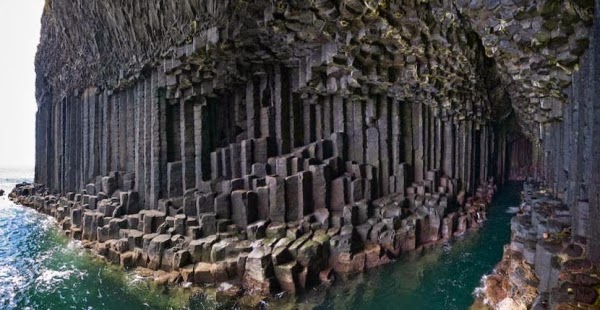Fingals Cave
Fingal's Cave is an ocean surrender on the uninhabited island of Staffa, in the Inner Hebrides of Scotland, some piece of a National Nature Reserve claimed by the National Trust for Scotland. It got to be known as Fingal's Cave after the eponymous saint of an epic ballad by eighteenth century Scots artist antiquarian James Macpherson.
It is shaped altogether from hexagonally jointed basalt segments inside a Paleocene magma stream, comparative in structure to the Giant's Causeway in Northern Ireland and those of close-by Ulva.
In all these cases, cooling on the upper and lower surfaces of the hardened magma brought about compression and breaking, beginning in a blocky tetragonal example and transitioning to a normal hexagonal crack example with breaks perpendicular to the cooling surfaces. As cooling proceeded with these splits bit by bit stretched out at the inside of the stream, structuring the long hexagonal sections we see in the wave-disintegrated cross-area today. Comparable hexagonal break examples are found in drying up splits in mud where withdrawal is because of loss of water as opposed to cooling.
Its size and commonly angled top, and the spooky sounds delivered by the echoes of waves, provide for it the air of a characteristic basilica. The hollow's Gaelic name, A Uaimh Bhinn, signifies "the pleasant hole."
Little is known of the early history of Staffa, despite the fact that the Swiss town of Stäfa on Lake Zurich was named after the island by a friar from adjacent Iona. A piece of the Ulva home of the Macquarries tribe from an early date until 1777, the hole was brought to the consideration of the English-talking world by eighteenth century naturalist Sir Joseph Banks in 1772.
Etching of Fingal's Cave by James Fittler in Scotia Depicta
It got to be known as Fingal's Cave after the eponymous saint of an epic lyric by eighteenth century Scots artist student of history James Macpherson. It shaped piece of his Ossian cycle of sonnets asserted to have been focused around old Scottish Gaelic ballads. In Irish mythology, the saint Fingal is known as Fionn macintosh Cumhaill, and it is proposed that Macpherson rendered the name as Fingal (signifying "white more interesting") through a misunderstanding of the name which in old Gaelic would show up as Finn. The legend of the Giant's Causeway has Fionn or Finn building the interstate in the middle of Ireland and Scotland.
The cavern has an expansive angled passage and is filled by the ocean. A few neighborhood organizations incorporate a pass by the collapse touring travels from April to September. Be that as it may, it is likewise conceivable to land somewhere else on the island and stroll to the hole overland, where a line of cracked segments structures a walkway just above high-water level allowing investigation by walking. From within, the doorway appears to edge the island of Iona over the water.
Sentimental writer Felix Mendelssohn went to in 1829 and composed a suggestion, The Hebrides, Op. 26, (otherwise called Fingal's Cave suggestion), motivated by the bizarre echoes in the cavern. Mendelssohn's suggestion advanced the hole as a traveler goal. Different well known nineteenth century guests included writer Jules Verne who utilized it as a part of his book Le Rayon vert (The Green Ray); artists William Wordsworth, John Keats, and Alfred, Lord Tennyson; and Romantic craftsman J. M. W. Turner, who painted "Staffa, Fingal's Cave" in 1832. Ruler Victoria likewise made the outing.
Basalt sections inside Fingal's Cave
The dramatist August Strindberg additionally set scenes from his play A Dream Play in a spot called "Fingal's Grotto." Scots writer Sir Walter Scott depicted Fingal's Cave as "a standout amongst the most uncommon spots I ever observed. It surpassed, in my brain, each portrayal I had known about it… made altogether out of basaltic columns as high as the top of a house of God, and running profound into the rock, endlessly cleared by a profound and swelling ocean, and cleared, so to speak, with reddish marble, astounds all depiction."
Craftsman Matthew Barney utilized the hole alongside the Giant's Causeway for the opening and shutting scenes of his craft film, Cremaster 3. In 2008, the feature craftsman Richard Ashrowan used a few days recording the inner part of Fingal's Cave for a show at the Foksal Gallery in Poland.
One of Pink Floyd's initial melodies bears this current area's name. This instrumental was composed for the film Zabriskie Point however not utilized.
Lloyd House at Caltech has a painting speaking to Fingal's Cave. The passage that gimmicks this painting additionally houses a wooden statue named Fingal, which is among the most established treasures at the establishment.
Door to Fingal's hole, 2004
Scottish Celtic rock band Wolfstone recorded an instrumental titled Fingal's Cave on their 1999 collection Seven.
Fingals Cave
 Reviewed by Ali Hamza
on
13:50
Rating:
Reviewed by Ali Hamza
on
13:50
Rating:
 Reviewed by Ali Hamza
on
13:50
Rating:
Reviewed by Ali Hamza
on
13:50
Rating:


No comments